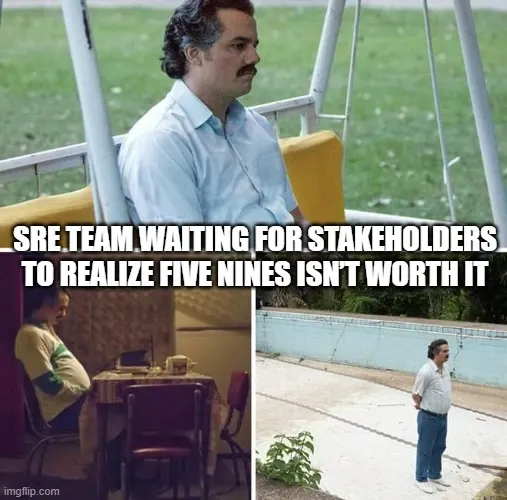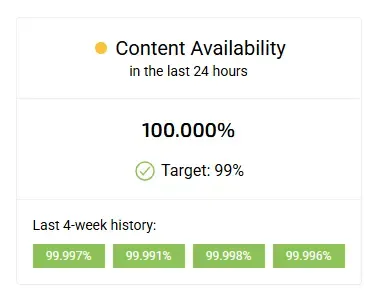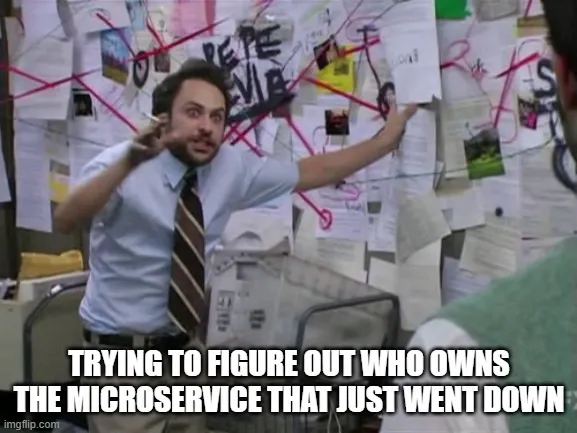The Truth About 99.999% SLO: Are You Being Misled?

Published on 14 August 2025 by Zoia Baletska

Service Level Objectives (SLOs) stand as the gold standard for measuring reliability, yet we might be focusing on the wrong targets. A 2024 BCG study reveals that only 3% of companies are ready to welcome innovation. This same reluctance to question established practices affects our approach to SLOs.
Companies increasingly set aggressive availability targets, but many don't grasp what SLO means or how it is different from an SLA. The quest for perfection through a 99.999% SLO mirrors a broader trend - much like how 42% of drivers wonder if trading their privacy for promised benefits makes sense. Teams waste countless hours and resources before they realize these ultra-high targets might not serve their purpose.
Let me explain why 99.999% SLOs could set your team up for failure and help you establish objectives that create business value without unnecessary pressure.
What Is an SLO and Why It Matters
A Service Level Objective (SLO) represents a specific, measurable target that defines a service's expected performance during a set time period[1]. Perfect reliability isn't the goal - SLOs create realistic measures that line up technical capabilities with customer expectations.
Reliability engineering depends on SLOs that turn abstract promises into measurable goals. Engineering teams use these internal performance targets to maintain service quality at defined standards. An email service could set its availability SLO at 99.9%, which allows roughly 8.76 hours of downtime per year[2].
Understanding the difference between SLOs and SLAs (Service Level Agreements) makes all the difference. SLAs create formal contracts between providers and customers with penalties for missed targets. SLOs represent individual promises within these agreements[3]. SLOs work for both external and internal services, while SLAs typically cover paying customers only.
SLOs prove valuable and with good reason too:
-
Users get clear expectations about service reliability, which prevents misunderstandings
-
The core team can prioritise work based on what users truly care about
-
Organisations find the sweet spot between accepting new ideas and reliability, avoiding targets that are too aggressive or too lenient
-
Teams get measurable targets to improve continuously
Remember this crucial point: chasing 100% reliability hurts more than it helps. Perfect performance remains technically impossible to achieve. The cost would be nowhere near worth it[4]. The quest for 100% reliability would stop you from updating or improving your service[5].
Business outcomes depend on SLOs through customer experience. Smooth user interactions build loyalty and satisfaction when services meet their SLOs consistently. Research shows that 30% of users switch to alternatives when problems are systemic.
Successful SLOs depend on choosing the right Service Level Indicators (SLIs) - specific metrics that track service performance. These metrics typically include availability, latency, throughput, and error rates. The final selection should reflect your users' priorities.
Why 99.999% SLO Is Often a Red Flag
Many organizations get dazzled by 99.999% uptime—the coveted "five nines"—without seeing what it really means. Here's the reality: five nines gives you just 5 minutes and 15 seconds of allowed downtime per year[6]. This looks great on paper until you see what it takes to get there.

Going after five nines reliability creates big problems. Each extra nine you add to your availability percentage costs ten times more[7]. So companies chasing this goal often spend their money wrong. They put too much effort into tiny reliability gains instead of building features their customers want.
Modern application delivery makes five nines even harder to achieve. Your customer-facing service needs all its supporting services to be even more reliable. This creates a domino effect of tougher requirements across your whole system.
Your customers can't tell the difference between three or four nines and five nines. Three nines (99.9%) lets you have 8 hours and 45 minutes of downtime each year—still great and much easier to achieve. Many services waste resources trying to go beyond this point when they could invest that money better elsewhere.
Five nines forces you to:
-
Deploy new features less often
-
Pay for expensive 24/7 support teams
-
Build complex backup systems in multiple regions
-
Spend way more on infrastructure
This standard can hurt your business by slowing down progress. Teams become scared to make changes because they might affect their strict uptime goals[8]. One SRE expert puts it well: "Error budgets shift the mindset from fear of failure to permission to learn. That's where real product velocity begins".
Don't get stuck on random reliability numbers. Set realistic SLOs that match what your users expect. Look at which services really need super-high availability. Everything else might work better with lower targets that let you deliver more value faster.
How to Define SLOs That Actually Work
Understanding what reliability means to your users is the first step in creating effective SLOs. Many teams focus on technical metrics without consulting their actual service users, which becomes a common mistake.
Your SLOs will drive real value by mapping critical user trips. The key lies in identifying interactions that affect user satisfaction, such as checkout processes or authentication services. An e-commerce site might prioritize checkout completion times with this objective: "99.9% of transactions should complete within two seconds over a rolling 30-day period".
You should know your current performance before setting SLO targets. Teams often make the mistake of setting unrealistic objectives that create unnecessary stress. A baseline performance needs at least 30 days of historical data before you set any targets.

Service Level Indicators (SLIs) should reflect user experience exclusively. CPU usage and similar metrics don't affect users directly and won't serve as helpful SLIs. The RED method offers a good framework: Rate (requests per second), Errors (failed requests), and Duration (processing time).
Your SLOs don't need to exceed user requirements. Users might not notice the difference between 300ms and 500ms response times. The higher threshold costs less and delivers an identical experience.
Error budgets help balance reliability and state-of-the-art improvements. They set acceptable unreliability limits (typically 100% minus your SLO percentage). A depleting error budget signals the need to focus on reliability instead of new features.
Regular SLO reviews with stakeholders should happen monthly. These meetings help refine targets based on customer feedback. Your SLOs will stay relevant as they evolve with business needs and user expectations, avoiding static objectives that lose meaning over time.
Conclusion
SLOs work best when teams find the balance between customer satisfaction and operational efficiency rather than chasing perfect reliability. Our discussions showed that seeking 99.999% availability often results in diminishing returns and can hinder new breakthroughs.
Customers rarely notice the difference between four nines and five nines of availability. The substantial cost difference between these levels could fund new features or improvements that users will actually value and appreciate.
Error budgets provide a better approach to reliability. Teams now focus on using allowed failures wisely instead of avoiding all failures. This change enables teams to experiment and invent without constant worry about uptime metrics.
Successful SLOs depend on understanding your users' actual needs rather than pursuing arbitrary technical perfection. Your team should collect data, identify critical user experiences and set reasonable targets based on actual performance. These SLOs need updates as your service and user expectations evolve.
Teams should question their need for those extra nines. The main objective isn't perfect reliability but delivering consistent value that satisfies users while letting your team improve the service continuously. When you create SLOs that maintain this balance, you'll develop both a more reliable product and a more sustainable engineering culture.
Supercharge your Software Delivery!
Implement DevOps with Agile Analytics
Implement Site Reliability with Agile Analytics
Implement Service Level Objectives with Agile Analytics
Implement DORA Metrics with Agile Analytics





